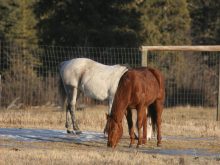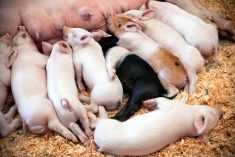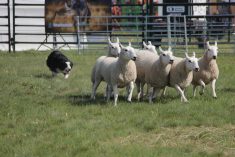A just-in-time dump of snow should get the grass growing in dried-out regions of southwestern Alberta.
Yet many say much more moisture is needed to refill empty dugouts, green up the grass and restore depleted subsoil reserves.
A major spring storm hit southern Alberta on April 2-4, leaving accumulations of 20 to 60 centimetres of snow extending from the foothills between Calgary and Cardston.
For rancher Hugh Lynch-Staunton at Lundbreck, the snowfall was a mixed blessing.
“It’s a wonderful bunch of moisture, but we’re right in the middle of calving,” he said.
Read Also

Why selenium is still an important factor in horse health
Selenium is an essential equine trace mineral that supports antioxidant defense, muscle integrity, immune function, metabolism and thyroid activity.
With a high wind chill and drifting snow, some calves didn’t survive. The only way around the ranch to help cows was by snowmobile, horseback and four wheel drive tractor.
He got more than 75 cm of snow accompanied by a 65 km-h wind. Another 2.5 cm of rain and snow arrived during the weekend of April 7.
Further east, the snow seemed to peter out. Karen Gordon, who ranches at Hanna, said they received about five cm of snow on April 3.
“It didn’t even settle the dust in the corrals,” she said.
Moisture-bearing weather systems have bypassed the Hanna area this winter. Gordon’s region has had little snow and since there is no frost in the ground, rain and snow should soak straight down.
“We seem to be getting sandblasted out here.”
In most parts of the south, this is the first major precipitation in a year, said Cardston County agriculture fieldman Rod Roggin.
The far southwest received from 60 to 90 cm of snow, with more in the mountains toward Waterton National Park.
“This snow is really going to help us,” he said.
Dugouts are dried out and livestock water supplies are critically low.
St. Mary’s Reservoir is at its lowest level in recent memory and considerably more precipitation will be needed to refill the reservoir that provides irrigation water from Cardston to Medicine Hat.
On a positive note, most of the snow has lingered rather than disappeared in fierce chinook winds. It is slowly soaking into the ground and should improve the moisture situation, said beef specialist Pat Ramsey at High River.
“People were getting pretty nervous about cropping and what they might do with their cattle,” he said.
In southeastern Alberta, crop specialist Dave Spencer said some snow fell last week, which should green up the grass. However, this latest precipitation was only enough to wet the ground.
Seeding should be extra early this year to capture the scarce moisture needed for germination. Spencer expects many farmers in his area will start field work in the next 10 days.
Canola was already going into the ground at Schuler, east of Medicine Hat on April 9.
Alberta Environment reports snowpack continues much below normal and forecasts a poor amount of runoff.
Spring runoff is complete in the Grande Prairie, Whitecourt, Edmonton, Lloydminster, Coronation and Red Deer areas.















